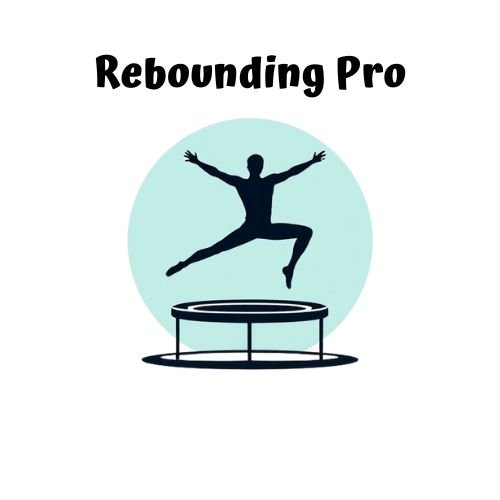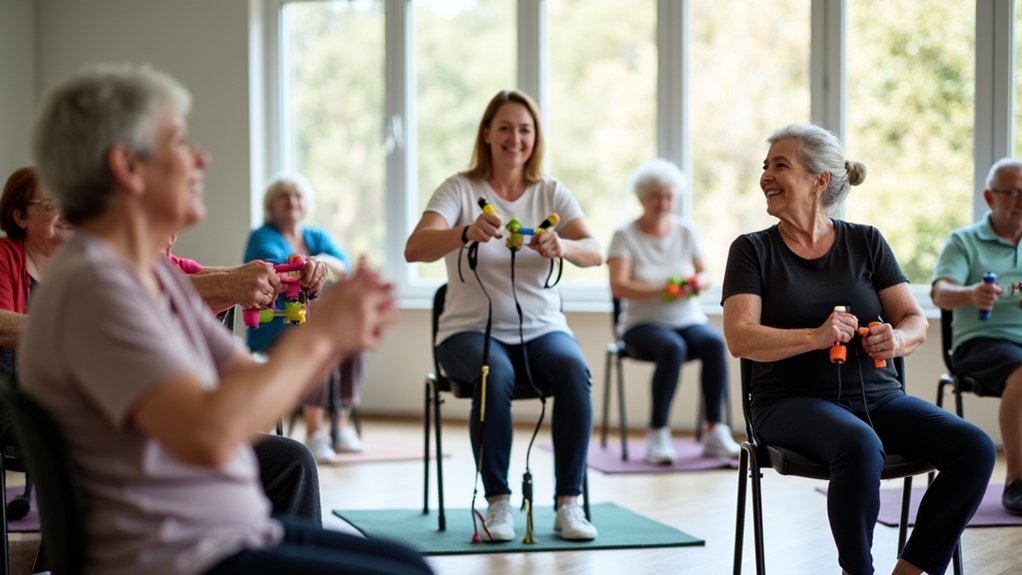Small space cardio burns maximum calories through efficient metabolic techniques like HIIT and rebounding. You’ll torch up to 18 calories per minute with high-intensity movements that engage multiple muscle groups simultaneously. Mini-trampolines are particularly effective, offering men 12.4 and women 9.4 calories burned per minute—equivalent to running at 8 mph but with 80% less joint impact. The unique G-force fluctuations create a metabolic afterburn that continues long after your workout ends.
The Science Behind Calorie Burn in Compact Workouts

While most people associate effective cardio with outdoor running or gym equipment, the science behind compact workouts reveals they can be equally powerful calorie-burning tools. The secret lies in physiological mechanisms like excess post-exercise oxygen consumption (EPOC), which elevates your metabolic rate long after you’ve finished exercising.
When you perform high-intensity movements like mountain climbers or jumping jacks in a small space, you’re engaging multiple muscle groups simultaneously, creating higher energy expenditure than isolated movements. Mountain climbers burn approximately 7 to 12 calories per minute while requiring minimal floor space.
Shorter rest intervals maintain elevated heart rates throughout your session, maximizing calorie burn per minute. Even bodyweight exercises like burpees notably increase oxygen consumption—directly correlating with calorie expenditure.
The best part? HIIT protocols in limited spaces can match or exceed traditional cardio’s effectiveness, burning up to 18 calories per minute.
Mini-Trampolines: Maximum Burn in Minimal Space
Four square feet is all you need to create a calorie-burning powerhouse in your home with a mini-trampoline. This compact exercise tool delivers impressive results, with men burning 12.4 calories per minute and women burning 9.4 calories per minute during structured routines—outperforming traditional low-impact aerobics by 2x.
Transform your living space into a fitness center with a mini-trampoline—the compact calorie-crusher that doubles the burn of traditional aerobics.
Mini-trampolines offer advantages that make them perfect for apartment dwellers and space-conscious exercisers:
- Burns up to 470 calories in 30 minutes, matching running at 8 mph
- Provides quiet, low-impact workouts suitable for shared living spaces
- Allows intensity scaling from beginner to advanced without additional equipment
- Costs considerably less than treadmills or ellipticals
- Enhances post-workout metabolism through EPOC effects
Scientific validation confirms mini-trampolines deliver vigorous exercise exceeding 6 METs while reducing joint strain compared to ground-based alternatives. Research shows significant improved body composition after 12 weeks of consistent rebounding exercise.
HIIT Rebounding: Torching Calories in Your Living Room

Combining the fat-torching benefits of high-intensity interval training with a mini-trampoline creates one of the most efficient home workouts possible. You’ll burn up to 405 calories in just 40 minutes, with men torching 12.4 calories per minute and women 9.4 calories per minute during intense intervals. The increased calorie burn is largely due to the powerful G-Force effect experienced during rebounding exercises.
| Benefit | Timeframe | Result |
|---|---|---|
| Fat Loss | 4 weeks | 1.26% body fat reduction |
| Visceral Fat | 12 weeks | 19.5% decrease |
| Waist Size | 10 weeks | 3 cm reduction |
HIIT rebounding requires minimal space but delivers maximum results—burning 36.34% more calories than moderate cardio. Even a single weekly 23-minute session improves cardiovascular health. Your metabolism stays elevated post-workout, shifting energy utilization from carbs to fat during recovery while building lean muscle mass.
Small Equipment, Big Results: The Metabolic Advantage
You’ll discover remarkable metabolic benefits from using compact fitness tools that require minimal space but deliver maximum results.
Resistance band supersets can effectively target multiple muscle groups, increasing your metabolic rate and creating lasting calorie-burning effects long after your workout ends.
Incorporating a simple jump rope into your routine provides an intensive metabolic boost, engaging your entire body while improving cardiovascular health in just a few square feet of space.
Research shows that high-intensity exercises like jumping rope can produce benefits comparable to moderate-vigorous physical activity, which has the strongest protective associations with cardiometabolic health outcomes.
Compact Equipment Efficiency
While many assume large, commercial-grade equipment is necessary for effective cardio, compact fitness machines pack a surprising metabolic punch in limited spaces.
Today’s space-saving designs deliver efficiency without sacrificing results, with ellipticals burning up to 800 calories per hour and even SkiErgs offering 420 calories burned at moderate intensity.
You’ll maximize your calorie-burning potential with compact equipment through:
- Adjustable resistance levels tailored to your fitness stage
- Versatility supporting both HIIT and LISS workout styles
- Enhanced EPOC effect extending calorie burn post-workout
- Interactive displays providing real-time feedback for peak form
- Portability allowing workout placement anywhere in your home
The combination of intensity options and technological features makes compact equipment not just a space-saving alternative, but often the smarter fitness choice. For beginners especially, compact equipment can provide higher calorie burn due to the inefficient movement patterns that naturally occur when learning new exercise forms.
Resistance Band Supersets
Resistance bands represent the perfect complement to compact cardio machines, offering remarkable metabolic benefits without demanding additional square footage. When used in supersets, these versatile tools elevate your heart rate to 70-85% of maximum—comparable to moderate cycling or dancing.
You’ll burn approximately 108 calories in just 30 minutes while simultaneously engaging multiple muscle groups. Research shows black band exercises average 3.52 METs, providing greater calorie-burning potential than blue bands. By minimizing rest between exercises, you’ll maintain elevated heart rates and create an EPOC effect that continues burning calories long after your workout ends.
The true advantage lies in their efficiency: bands accommodate progressive overload without equipment changes, allowing you to perform compound movements like squat-to-press sequences that maximize calorie burn.
Try incorporating 3-5 weekly sessions of 30-45 minutes, using slow eccentric phases (4-6 seconds) to dramatically increase time under tension and optimize results.
Jump Rope Metabolic Boost
Despite requiring minimal space and investment, jump rope training delivers a metabolic powerhouse effect that outperforms many larger cardio machines.
You’ll burn 500-1,000 calories per hour depending on your weight, with just 10 minutes matching a 30-minute jog’s cardiovascular benefits.
- Heavy ropes like Muay Thai 2.0 maximize calorie burn through increased resistance
- Fast-twitch muscle fibers activate during explosive jumps, enhancing metabolic demand
- Alternating 30-second max efforts with 30-second rest periods optimizes calorie expenditure
- Advanced techniques like double-unders greatly elevate heart rate and energy output
- Post-workout afterburn effect continues burning calories long after you’ve finished
Even 15-20 minutes daily provides sufficient intensity for weight loss when combined with proper nutrition, making jump rope your small-space metabolic secret weapon. Recent testing shows the Heavy Rope burns an impressive 13.6 calories/minute, ranking it the most effective option among popular jump rope styles.
Rebounding vs. Traditional Cardio: Calorie Comparison
You’ll burn comparable calories on a rebounder as you’d running (around 234 calories in 30 minutes), but with roughly 80% less joint impact.
The mini-trampoline’s metabolic advantage comes from continuous micro-adjustments that engage your entire body while maintaining an average heart rate of 148 bpm. This workout is enjoyable and fun, making it easier to maintain consistency with your exercise routine.
Your perceived exertion remains lower on a rebounder, allowing longer sessions and potentially greater calorie expenditure over time despite the compact footprint.
Space-Efficient Calorie Torching
The battle between rebounding and traditional cardio reveals surprising calorie-burning potential in a fraction of the space. While treadmills demand 30+ square feet, a rebounder needs less than 10—perfect for apartment living without sacrificing results.
You’ll get impressive calorie burn while saving precious floor space:
- ACON’s tests showed rebounding burned 234 calories in 30 minutes versus running’s 218 calories
- High-intensity sessions can torch up to 876 calories, rivaling traditional cardio
- Vertical storage options make rebounders practically disappear when not in use
- No weather constraints or gym commutes means consistent daily workouts
- Set up in under 5 minutes on any surface—carpet, hardwood, or tile
Your small-space workout doesn’t just save room—it might actually deliver better results than bulkier alternatives. Research has consistently shown that rebounding burns more calories than typical cardio workouts like running, swimming, or cycling.
Rebounding’s Metabolic Edge
When comparing calorie-burning potential, rebounding surprisingly outperforms many traditional cardio exercises while being gentler on your body.
You’ll burn between 250-400 calories per hour at moderate intensity, with some sessions reaching up to 876 calories.
What sets rebounding apart is its efficiency—a 30-minute non-stop session burns approximately 234 calories without the joint stress of running.
You’re getting nearly twice the cardiovascular benefit with considerably less impact, making it sustainable for consistent workouts.
The “fun factor” shouldn’t be underestimated either.
You’re more likely to stick with exercise that feels like a dance party than one that leaves you dreading tomorrow’s soreness.
Rebounding offers a comprehensive workout that engages major muscles throughout your entire body while providing cardiovascular benefits.
For maximum results, consider combining rebounding with traditional cardio to keep your fitness routine fresh and challenging.
Designing Your Space-Efficient Rebounding Routine

Creating an effective rebounding routine doesn’t require expansive space, which makes this exercise format perfect for apartment dwellers and those with limited workout areas.
Start with a 5-minute dynamic warm-up before diving into 15 minutes of higher-intensity bouncing, followed by stabilization work and a gentle cool-down.
Your routine should include:
- Progressive intensity—begin with 10-minute sessions and gradually extend to 30 minutes
- Varied movements like jumping jacks, knee raises, and twists to engage multiple muscle groups
- Modifications based on your fitness level (seated bounces for beginners, tuck jumps for advanced)
- Strategic intervals (30 seconds intense/30 seconds recovery) to maximize calorie burn
- Optional ankle weights or resistance bands to increase challenge as you improve
For maximum effectiveness, maintain proper posture with soft knees throughout your workout to reduce impact and protect your joints while optimizing calorie burn.
Beyond Weight Loss: Hidden Benefits of Compact Rebounding
While most people think of rebounding as primarily a weight loss activity, its benefits extend far beyond shedding pounds in small spaces. Your body experiences remarkable transformations at cellular and systemic levels. Mini-trampolines provide greater stability and safety compared to large backyard trampolines, making them an ideal option for home fitness routines.
| Benefit Category | What You’ll Gain |
|---|---|
| Metabolic | VO₂ max increase from 15.4 to 16.9 mL/kg/min; work capacity jumps from 104 to 123 watts |
| Cardiovascular | Blood pressure reduction from 128/80.5 to 123/71 mmHg; enhanced oxygen delivery |
| Musculoskeletal | Improved bone density, especially in femur neck and lumbar regions; increased lean muscle mass |
| Recovery | Lymphatic drainage stimulation; reduced pain interference; improved balance and coordination |
These measurable improvements occur because rebounding creates unique G-force fluctuations that stimulate multiple body systems simultaneously, making it an efficient workout choice even when space is limited.
Frequently Asked Questions
Can Small Space Cardio Workouts Help Reduce Targeted Body Fat?
Yes, you can reduce targeted body fat with small space cardio workouts when combined with proper nutrition. While spot reduction has limited evidence, consistent high-intensity exercises will help decrease overall body fat, including problem areas.
How Many Calories Does Jumping Rope Burn Compared to Rebounding?
You’ll burn 10-20 calories per minute jumping rope versus 5-10 calories with rebounding. At 11.8 MET, rope skipping outperforms rebounding’s 5-7 MET range, making it more efficient for calorie burning.
Are Mini-Trampoline Workouts Safe for People With Joint Problems?
Yes, mini-trampoline workouts are generally safe for your joints. You’ll benefit from their low-impact nature, but you should still consult your healthcare provider first and maintain proper form during exercise.
What’s the Optimal Workout Duration for Maximum Afterburn Effect?
You’ll maximize afterburn with 20-30 minute high-intensity sessions rather than longer workouts. Prioritize strength or HIIT training 2-3 times weekly, aiming for 75-95% of your max heart rate during intense intervals.
Can Small Space Cardio Effectively Build Visible Muscle Definition?
Yes, you can build visible muscle definition with small-space cardio. HIIT protocols, kettlebell swings, and bodyweight circuits trigger hypertrophy while progressive overload and proper recovery guarantee continued growth, especially when combined with appropriate nutrition.
In Summary
You don’t need a gym membership or massive equipment to transform your body. By incorporating rebounding exercises into your compact living space, you’re maximizing calorie burn while minimizing impact on your joints. Whether you’re short on space, time, or both, these efficient workouts deliver impressive results. Start small, stay consistent, and you’ll discover that effective fitness doesn’t require square footage—just smart movement choices.





Leave a Reply